Illustration and gallery markets have traditionally been seen as a largely male profession, but women have always been active participants—from Kewpie creator Rose O’Neill in the early 20th Century, to 1950s Disney film designer Mary Blair to Spectrum Grand Masters Diane Dillon and Kinuko Y. Craft. Increasingly, women are impacting the world of contemporary fantastic art and inspiring new generations of illustrators, designers, sculptors, and painters.
Women of Wonder, edited by Cathy Fenner, reflects of the expanding numbers of women artists featured in Spectrum: The Best in Contemporary Fantastic Art. This full-color collection, complete with artist statements and photos, acknowledges their presence and influence. Women of Wonder is available May 19th from Underwood Books. Below, read Lauren Panepinto’s introduction, and preview some of the gorgeous artwork featured in the collection.
(Click any image to enlarge.)
I’ve always found it amusing when people talk about science fiction and fantasy as a relatively modern invention. Was Jules Verne the first author of science fiction? Was it Mary Shelley? Were the Pre-Raphaelites the first fantasy artists? Does the movement we call “Fantastic Art” start with illustrations for the Gothic novels of the eighteenth century, or not until the Pulp Era in the twentieth century?
I think we’re not only looking at the wrong centuries, but at the wrong geologic age. I believe we have to go back to the roots not just of civilization, but of humanity itself to find the beginnings of “Fantastic Art.” Around ancient campfires, the first humans tried to explain the universe using their imaginations, creating gods in their own image. They saw thunder and lightning and volcanoes, and created stories to explain them. Now we call them myths. Seen in this light, is there that much difference between the ancient myth of Zeus and the modern myth of Superman? J. R. R. Tolkien himself said that he did not set out to write a fantasy trilogy, but instead to create a new mythology for his beloved Britain. Myths and fantasy and science fiction all spring from the same well of imagination.
Anthropology tells us these pre- and proto-literate cultures were often led by priestesses, and female deities were supreme in their pantheon of gods. Archaeological evidence proposes that women were the makers and keepers of myth in those Stone Age civilizations. Those times are shrouded in the dense mists of history, but it is very possible that the oldest art we have—painted on the walls of caves—was religious and fantastical and was very likely created, at least in part, by women. I find it fitting to recall this as we embark on a tour of modern women mythmakers and visual storytellers.
Over time, our cultures and our civilizations shifted to a more patriarchal view. Although women continued to participate in both the fantastic and artistic, the spotlight mostly belonged to men. We are only recently unearthing and lauding the lives of women like Artemisia Gentileschi and Camille Claudel, who fought uphill battles to carve out careers in art for themselves. Women never stopped making art, but the writers of history often overlooked their accomplishments.
In the last few generations we have seen our society inch closer and closer to equality between the sexes in many areas,and yet women who were artists with successful careers still remained the exception. There are many debates over why this has been the case—societal pressure, sexism, the responsibilities of motherhood, a lack of self-confidence—the same arguments about women dropping out or “leaning in” in any career also apply to art.
As an Art Director, it is my job to know all the up and coming talent in my field. In the six years I have been at Orbit Books, and specifically commissioning Fantastic Art, I have reviewed countless portfolios and met hundreds of artists atall stages of their careers. I am in a perfect position to observe the deep currents of change that move our field. In recent years, it feels like the gender ratio in the art world is shifting. I look at this newest generation of artists working in Fantastic Art, recently graduating and now trying to establish their careers, and women are not only present, they are definitely no longer the exception. I see young women refusing to accept the sexism in our genre. I see them choosing to have children and careers. I see them decimating the antiquated clichés of what subjects “lady artists” are allowed to paint. And if you talk to these young artists, they immediately name the women who serve as their own artistic heroes—the ones a generation ahead of them, who showed them the way. These womendon’t question their right to a place in the world of Fantastic Art because of the trailblazers who fought for a woman’s right to prosper in this genre. For every Karla Ortiz and Rovina Cai and Rebecca Yanovskaya there has been a Kinuko Craft and a Terryl Whitlatch and a Rebecca Guay who forged the path, and who are still shining the light on the road ahead.
Seeing the art of so many talented women collected together in one book, we can really begin to appreciate how the feminine point of view colors the world of Fantastic Art. Although there are a wide variety of styles and subjects represented, there are also many points of similarity from which common ground emerges. In a genre often overpowered by the male perspective, this book offers us a unique opportunity to savor how distinctive and wonderful the fruits of a female imagination can be.
I myself am a female artist and I have idolized many of the women in this book. As much of a geek as I was growing up, it wasn’t until I saw these women’s names on book jackets and trading cards and comic books that I realized I, too, could make a career for myself in art. The fact that I also came to work in the realm of Fantastic Art, and that I can commission many of my idols, is a dream come true. It was a dream I cultivated back in the days when I was trying to learn to draw by copying Jody Lee’s book covers and Rebecca Guay’s Magic: The Gathering cards. Without many of the women in this book, I would never have been inspired to find my own career in art, and it is an honor to introduce them and this collection.
It is important to celebrate the women who have already established successful careers in Fantastic Art—careers that are still going strong—and it is a tribute to them that in the same book we highlight the younger careers they have inspired.
Excerpted from Women of Wonder © 2015










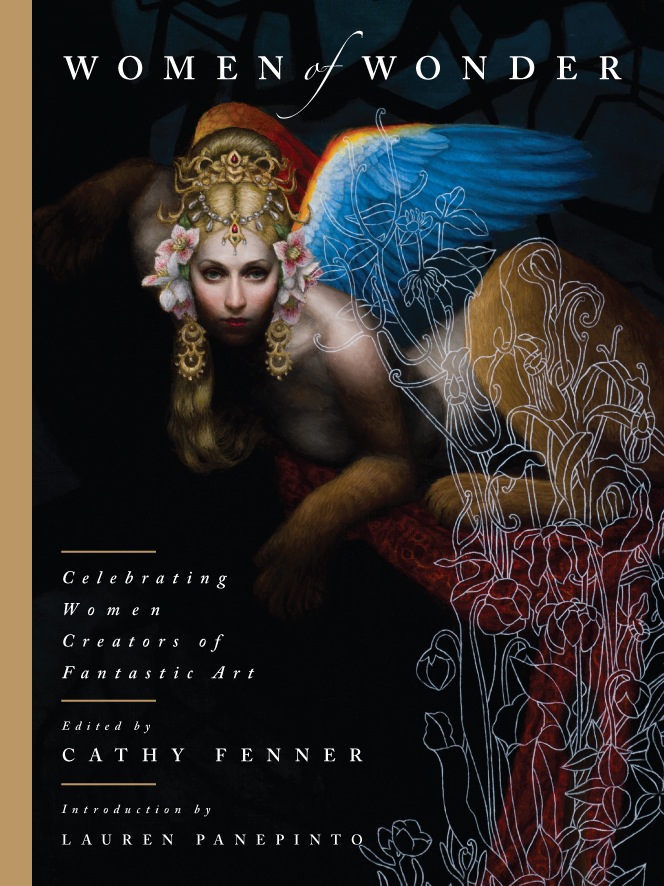
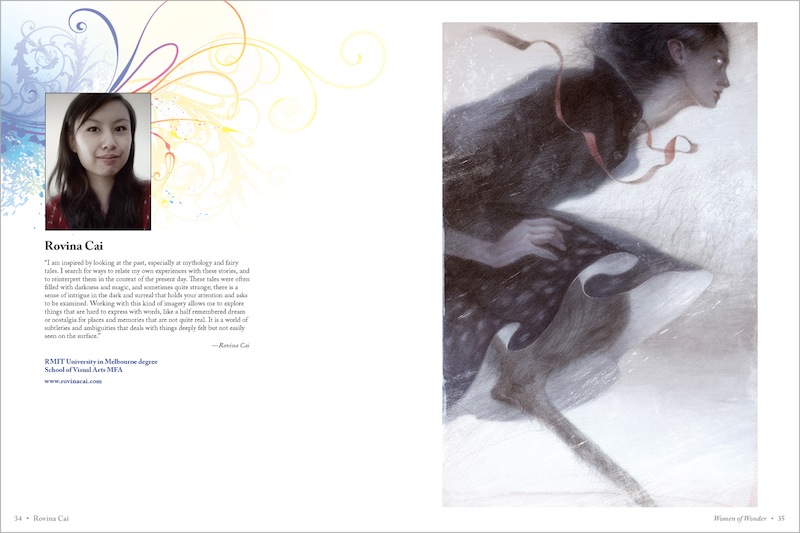
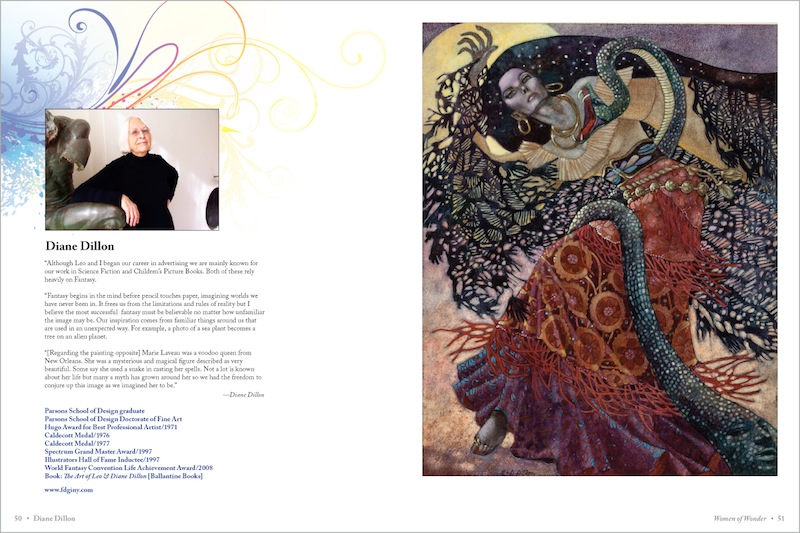
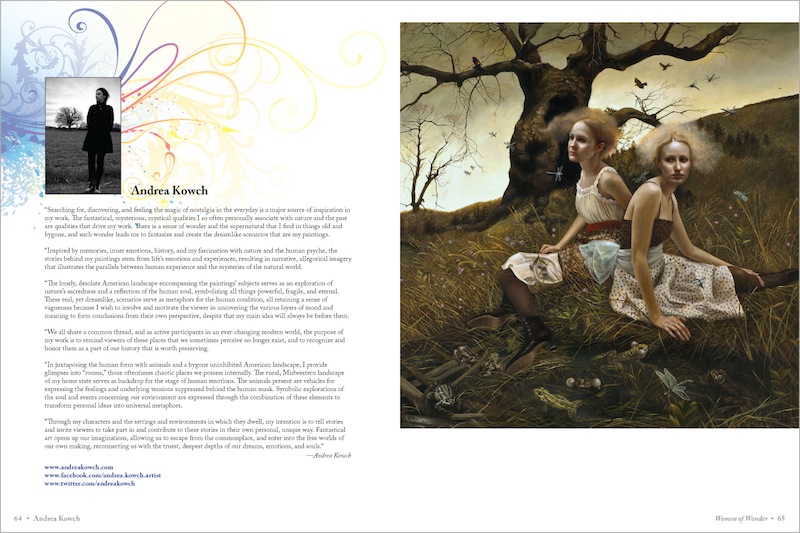
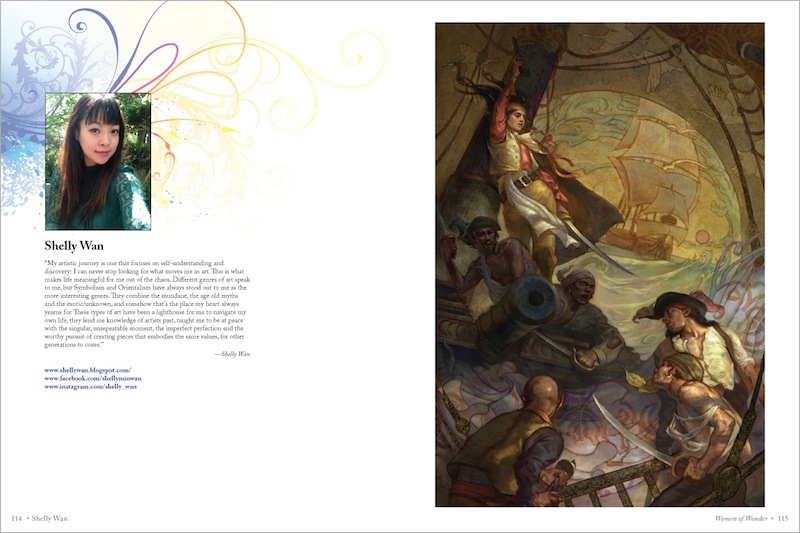
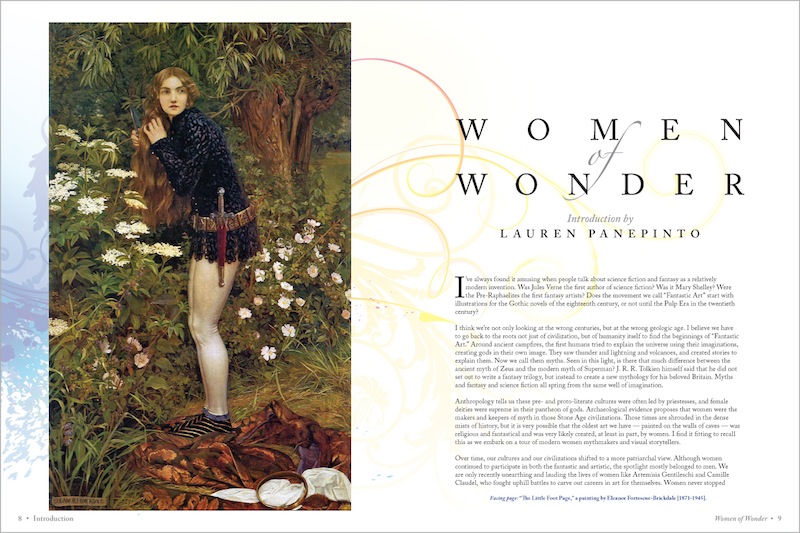

The title has been used before, for a prose series with similar ambitions*. Is your choice of title a homage?
“I see young women refusing to accept the sexism in our genre.”
I saw this, again over in prose, back in the 1970s and then I saw a concerted effort not just to undo the progress that had been made but to erase the knowledge that it had ever happened. A fairly successful effort, so keep your guard up.
* http://jamesdavisnicoll.com/reviews/series/women-of-wonder
I am so happy to see Diane Dillon’s name and image. I’ve been on pins and needles waiting for her to start working solo.